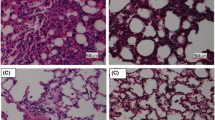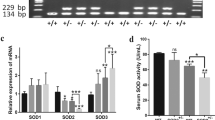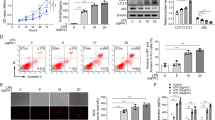Abstract
Objective
Obstructive sleep apnea is closely related to oxidative stress. 4-hydroxy-2,2,6,6-tetramethylpiperidine-1-oxyl (Tempol) can scavenge reactive oxygen species (ROS) and ameliorate oxidative damage in the body. The mechanism by which Tempol alleviates chronic intermittent hypoxia-induced lung injury has rarely been reported. This study aimed to confirm the molecular mechanism by which Tempol alleviates lung injury.
Methods
The levels of miR-212-5p and Sirtuin 6 (SIRT6) in injured lungs were analyzed using bioinformatics. In vitro, intermittent hypoxia (IH) treatment induced hypoxia in BEAS-2B cells and we established a model of chronic intermittent hypoxia (CIH) in mouse using a programmed hypoxia chamber. We used HE staining to observe the morphology of lung tissue, and the changes in lung fibers were observed by Masson staining. The levels of inflammatory factors in mouse serum were detected by ELISA, and the levels of the oxidative stress indicators GSH, MDA, SOD and ROS were detected using commercially available kits. Moreover, a real-time qPCR assay was used to detect miR-212-5p expression, and Western blotting was used to detect the levels of SIRT6, HIF-1α and apoptosis-related proteins. CCK-8 was used to detect cell proliferation. Subsequently, we used flow cytometry to detect cell apoptosis. Dual-luciferase gene reporters determine the on-target binding relationship of miR-212-5p and SIRT6.
Results
SIRT6 was highly expressed in CIH-induced lung injury, as shown by bioinformatics analysis; however, miR-212-5p expression was decreased. Tempol promoted miR-212-5p expression, and the levels of SIRT6 and HIF-1α were inhibited. In BEAS-2B cells, Tempol also increased proliferation, inhibited apoptosis and inhibited oxidative stress in BEAS-2B cells under IH conditions. In BEAS-2B cells, these effects of Tempol were reversed after transfection with an miR-212-5p inhibitor. miR-212-5p targeted and negatively regulated the level of SIRT6 and overexpression of SIRT6 effectively reversed the enhanced influence of the miR-212-5p mimic on Tempol’s antioxidant activity. Tempol effectively ameliorated lung injury in CIH mice and inhibited collagen deposition and inflammatory cell infiltration. Likewise, the therapeutic effect of Tempol could be effectively reversed by interference with the miR-212-5p inhibitor.
Conclusion
Inhibition of the SIRT6-HIF-1α signaling pathway could promote the effect of Tempol by upregulating the level of miR-212-5p, thereby alleviating the occurrence of lung injury and providing a new underlying target for the treatment of lung injury.







Similar content being viewed by others
Data availability
The datasets used and/or analyzed during the current study are available from the corresponding author upon reasonable request.
References
Huang P, Zhou J, Chen S et al (2018) The association between obstructive sleep apnea and shortened telomere length: a systematic review and meta-analysis. Sleep Med 48:107–112
Tsou YA, Huang CW, Wu TF et al (2018) The effect of tongue base suspension with uvulopalato-pharyngoplasty on sleep quality in obstructive sleep apnea. Sci Rep 8(1):8788
Eisele HJ, Markart P, Schulz R (2015) Obstructive sleep apnea, oxidative stress, and cardiovascular disease: evidence from human studies. Oxid Med Cell Longev 2015:608438
Passali D, Corallo G, Yaremchuk S et al (2015) Oxidative stress in patients with obstructive sleep apnoea syndrome. Acta Otorhinolaryngol Ital 35(6):420–425
Gupta MA, Jarosz P (2018) Obstructive sleep apnea severity is directly related to suicidal ideation in posttraumatic stress disorder. J Clin Sleep Med JCSM Off Publ Am Acad Sleep Med 14(3):427–435
Hensen HA, Krishnan AV, Eckert DJ (2017) Sleep-disordered breathing in people with multiple sclerosis: prevalence, pathophysiological mechanisms, and disease consequences. Front Neurol 8:740
Chen J, Zhu H, Chen Q et al (2022) The role of ferroptosis in chronic intermittent hypoxia-induced lung injury. BMC Pulm Med 22(1):488
Zhang D, Ren L, Chen GQ et al (2015) ROS-induced oxidative stress and apoptosis-like event directly affect the cell viability of cryopreserved embryogenic callus in Agapanthus praecox. Plant Cell Rep 34(9):1499–1513
Hua W, Huang HZ, Tan LT et al (2015) CD36 mediated fatty acid-induced podocyte apoptosis via oxidative stress. PLoS ONE 10(5):e0127507
Zhang J, Wang X, Vikash V et al (2016) ROS and ROS-mediated cellular signaling. Oxid Med Cell Longev 2016:4350965
Racanelli AC, Kikkers SA, Choi AMK et al (2018) Autophagy and inflammation in chronic respiratory disease. Autophagy 14(2):221–232
Belaidi E, Morand J, Gras E et al (2016) Targeting the ROS-HIF-1-endothelin axis as a therapeutic approach for the treatment of obstructive sleep apnea-related cardiovascular complications. Pharmacol Ther 168:1–11
Kim SJ, Cheresh P, Williams D et al (2014) Mitochondria-targeted Ogg1 and aconitase-2 prevent oxidant-induced mitochondrial DNA damage in alveolar epithelial cells. J Biol Chem 289(9):6165–6176
Michishita E, McCord RA, Berber E et al (2008) SIRT6 is a histone H3 lysine 9 deacetylase that modulates telomeric chromatin. Nature 452(7186):492–496
Castro-Grattoni AL, Suarez-Giron M, Benitez I et al (2021) The effect of chronic intermittent hypoxia in cardiovascular gene expression is modulated by age in a mice model of sleep apnea. Sleep. https://doi.org/10.1093/sleep/zsaa293
Hu Y, Liu J, Huang H (2013) Recent agents targeting HIF-1α for cancer therapy. J Cell Biochem 114(3):498–509
Lu TX, Rothenberg ME (2018) MicroRNA. J Allergy Clin Immunol 141(4):1202–1207
Chen Q, Lin G, Chen Y et al (2021) miR-3574 ameliorates intermittent hypoxia-induced cardiomyocyte injury through inhibiting Axin1. Aging 13(6):8068–8077
Hao S, Jiang L, Fu C et al (2019) 2-Methoxyestradiol attenuates chronic-intermittent-hypoxia-induced pulmonary hypertension through regulating microRNA-223. J Cell Physiol 234(5):6324–6335
Lu H, Lin J, Xu C et al (2021) Cyclosporine modulates neutrophil functions via the SIRT6-HIF-1α-glycolysis axis to alleviate severe ulcerative colitis. Clin Transl Med 11(2):e334
Yang Z, Yu W, Huang R et al (2019) SIRT6/HIF-1α axis promotes papillary thyroid cancer progression by inducing epithelial-mesenchymal transition. Cancer Cell Int 19:17
Gou L, Zou H, Li B (2019) Long noncoding RNA MALAT1 knockdown inhibits progression of anaplastic thyroid carcinoma by regulating miR-200a-3p/FOXA1. Cancer Biol Ther 20(11):1355–1365
Si J, Jin Y, Cui M et al (2021) Neuroprotective effect of miR-212-5p on isoflurane-induced cognitive dysfunction by inhibiting neuroinflammation. Toxicol Mech Methods 31(7):501–506
El-Sayed NS, Mahran LG, Khattab MM (2011) Tempol, a membrane-permeable radical scavenger, ameliorates lipopolysaccharide-induced acute lung injury in mice: a key role for superoxide anion. Eur J Pharmacol 663(1–3):68–73
Gonzalez EJ, Peterson A, Malley S et al (2015) The effects of tempol on cyclophosphamide-induced oxidative stress in rat micturition reflexes. Sci World J 2015:545048
Li L, Lai EY, Luo Z et al (2017) Superoxide and hydrogen peroxide counterregulate myogenic contractions in renal afferent arterioles from a mouse model of chronic kidney disease. Kidney Int 92(3):625–633
Neil S, Huh J, Baronas V et al (2017) Oral administration of the nitroxide radical TEMPOL exhibits immunomodulatory and therapeutic properties in multiple sclerosis models. Brain Behav Immun 62:332–343
Salvi A, Patki G, Khan E et al (2016) Protective effect of tempol on buthionine sulfoximine-induced mitochondrial impairment in hippocampal derived HT22 cells. Oxid Med Cell Longev 2016:5059043
Xiong Y, Hall ED (2009) Pharmacological evidence for a role of peroxynitrite in the pathophysiology of spinal cord injury. Exp Neurol 216(1):105–114
Xiong Y, Singh IN, Hall ED (2009) Tempol protection of spinal cord mitochondria from peroxynitrite-induced oxidative damage. Free Radical Res 43(6):604–612
Wang Y, Hai B, Ai L et al (2018) Tempol relieves lung injury in a rat model of chronic intermittent hypoxia via suppression of inflammation and oxidative stress. Iran J Basic Med Sci 21(12):1238–1244
Li T, Zhang T, Gao H et al (2021) Tempol ameliorates polycystic ovary syndrome through attenuating intestinal oxidative stress and modulating of gut microbiota composition-serum metabolites interaction. Redox Biol 41:101886
Zhao HY, Chen BY, Guo R et al (2013) Impact of chronic intermittent hypoxia upon rat liver lipid metabolism and interventional effect of Tempol. Zhonghua Yi Xue Za Zhi 93(6):407–410
Climent M, Viggiani G, Chen YW et al (2020) MicroRNA and ROS crosstalk in cardiac and pulmonary diseases. Int J Mol Sci 21(12):4370
Zhang M, Liu W, Liu Y et al (2023) Astragaloside IV inhibited podocyte pyroptosis in diabetic kidney disease by regulating SIRT6/HIF-1α axis. DNA Cell Biol 42(10):594–607
Ho PTB, Clark IM, Le LTT (2022) MicroRNA-based diagnosis and therapy. Int J Mol Sci 23(13):7167
Acknowledgements
Not applicable.
Funding
This research is supported by the National Natural Science Foundation of China (Project Number: 81960025).
Author information
Authors and Affiliations
Contributions
Conceptualization, LA and LR; methodology, LA, YL and YC; software, YC and ZL; validation, XN; formal analysis, RL, YC, ZL and XN; investigation, LA and YL; resources, LA and YL; data curation, RL and YC; writing—original draft preparation, LA and YL; writing—review and editing, LA and YL; visualization, LR, YC, ZL and XN; supervision, LA and YL; funding acquisition, LA and YL. All authors have read and agreed to the published version of the manuscript.
Corresponding author
Ethics declarations
Competing interests
The authors declare that they have no competing interests.
Ethical approval
All animal experiments were approved by the Experimental Animal Ethics Committee of Kunming Medical University (kmmu20211432). All authors confirm that all the methods were in accordance with the ARRIVE guidelines.
Additional information
Publisher's Note
Springer Nature remains neutral with regard to jurisdictional claims in published maps and institutional affiliations.
Rights and permissions
Springer Nature or its licensor (e.g. a society or other partner) holds exclusive rights to this article under a publishing agreement with the author(s) or other rightsholder(s); author self-archiving of the accepted manuscript version of this article is solely governed by the terms of such publishing agreement and applicable law.
About this article
Cite this article
Ai, L., Li, R., Cao, Y. et al. 4-hydroxy-2,2,6,6-tetramethylpiperidine-1-oxyl (Tempol) alleviates lung injury by inhibiting SIRT6-HIF-1α signaling pathway activation through the upregulation of miR-212-5p expression. Mol Biol Rep 51, 129 (2024). https://doi.org/10.1007/s11033-023-09039-3
Received:
Accepted:
Published:
DOI: https://doi.org/10.1007/s11033-023-09039-3




